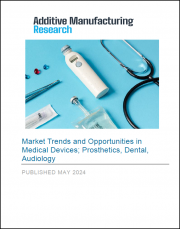
|
시장보고서
상품코드
1485308
의료기기 시장 동향과 기회 : 보철, 치과, 청각Market Trends and Opportunities in Medical Devices; Prosthetics, Dental, Audiology |
||||||
3D 프린트 의료기기 시장의 매출은 2023년 45억 달러에서 10년간 12%의 CAGR로 성장하며, 2034년에는 165억 달러에 달합니다.
3D 프린팅 기술의 활용은 의료 분야에 큰 영향을 미치고 있습니다. 맞춤형 의료기기 제조가 용이해지고, 개발 비용이 절감되고, 첨단 장비의 혁신이 촉진되고, 보철물에 대한 접근성이 향상되었습니다. 지난 20년간 의료의 통합은 환자의 치료 결과를 크게 개선하고 의료 접근성을 확대했습니다. 이 기술은 COVID-19 팬데믹 기간 중 의료기기 제조 문제를 해결하고, 공급망을 간소화하며, 의료기기 설계와 제조를 환자와 의료진 모두에게 더 가까이 다가갈 수 있도록 하는 데 중요한 역할을 했습니다. 향후 의료기기 산업, 특히 보철, 보청기, 치과 분야는 3D 프린팅 기술의 혜택을 계속 누리며 큰 성장을 이룰 것으로 예상됩니다.
이 보고서는 3D 프린팅이 혁신, 성장, 보급을 촉진하고 있는 가장 중요한 세 가지 의료기기 분야인 보철, 청각, 치과 분야에서의 3D 프린팅 시장 기회를 분석합니다. 시장 기회에는 치과용 3D 프린팅 플랫폼의 기술 발전, 의료 및 의료기기 공급망의 디지털화, 미국 식품의약국(FDA) 및 유럽의약품청(EMA)과 같은 규제기관의 지속적인 발전이 포함됩니다. 이들 기관은 지속적으로 의료기기 3D 프린팅에 대한 가이드라인을 발표하고 있습니다.
이 보고서는 또한 주요 업체(3D Systems, Formlabs, Stratasys, Materialise 등)의 의료기기 분야에 적용 가능한 3D 프린팅 기술 및 재료에 대해서도 조사했습니다.
보고서 구매자에게는 해당 분야의 10년 매출 예측을 기술, 재료, 서비스별로 분류한 광범위한 엑셀 데이터 파일이 제공됩니다.
목차
주요 요약
제1장 동향과 과제
- 동향
- 만성질환의 증가에 수반하여 환자 고유 디바이스가 증가할 전망
- 진화하는 규제 상황
- PoC(Point-of-Care) 3D 프린팅 : 의료용 3D 프린팅의 미래
- 과제
- 커스텀형 디바이스에 관한 규제 가이던스의 계속
- 학제적인 전문 지식의 필요성
- 의료기기 분야에서 3D 프린팅의 가치 제안 : 정의
제2장 전략적 도입 모델
- 자사 생산
- 기술 프로바이더 및 혁신 허브와의 제휴
- 학술·임상 연구 파트너십
- PoC(Point-of-Care) 생산
제3장 의료기기(보철, 청각, 치과) 분야에서 3D 프린팅의 활용 사례
- 외과용 기기
- 보철구 및 임플란트
- 인정 임플란트·디바이스의 지속적 확대
- 청각 검사기기
- 디지털 치과
- SmileDirectClub의 파산이 3D 프린트 치과용 얼라이너에 미치는 영향
제4장 기술, 재료, 소프트웨어
- 하드웨어
- 소비자용 3D 프린팅 : 임상 응용을 향해 능력개발을 계속
- 의료기기 전용 프린터로의 이동이 진행되는가?
- 치과용 3D 프린팅 전용 하드웨어 시스템이 선행
- 재료
- 포토폴리머
- 열가소성수지·열경화성 수지
- 금속
- 서비스
Additive Manufacturing Research 소개
KSA 24.06.10The 3D printed medical device market will reach $16.5 billion in revenues in 2034 growing from $4.5 billion in 2023 at a 10 year CAGR of 12%.
The use of 3D printing technology has had a significant impact on the healthcare sector. It has facilitated the production of personalized medical devices, reduced development costs, fostered innovation in advanced devices, and improved accessibility to prosthetics. Over the past two decades, its integration into healthcare has notably enhanced patient outcomes and expanded healthcare accessibility. This technology has played a crucial role in addressing challenges related to the production of medical devices during the COVID-19 pandemic, streamlined the supply chain, and brought device design and production closer to both patients and providers. Looking ahead, the medical device industry, particularly in prosthetics, audiology, and dental fields, is expected to see significant growth as these segments continue to benefit from 3D printing technology.
This study examines the current opportunities for 3D printing in prosthetics, audiology, and dental - the three most significant medical device segments where 3D printing is driving innovation, growth, and adoption. These opportunities encompass technological advancements in application-specific 3D printing platforms, particularly in dental, the ongoing digitization of healthcare and medical device supply chains, and the continued progress of regulatory agencies such as the U.S. Food and Drug Administration (FDA) and the European Medicines Agency (EMA), which are consistently releasing guidance for the 3D printing of medical devices.
Additionally, the report summarizes the 3D printing technologies and materials applicable to the medical device sector, from leading vendors such as 3D Systems, Formlabs, Stratasys, and Materialise.
Buyers of the report also receive an extensive Excel data file with a ten-year revenue forecast for the sector, segmented by technology, material, and services.
Table of Contents
Executive Summary
- E.1. Key Trends and Opportunities
- E.1.1. Patient-Specific Devices
- E.1.2. Regulatory Evolution
- E.1.3. Point-of-Care 3D Printing
- E.2. Challenges
- E.3. Strategic Adoption
- E.4. Forecasting
Chapter One: Trends and Challenges
- 1.1. Trends
- 1.1.1. Patient-specific Devices are Set to Increase to Meet a Rise In Chronic Disease
- 1.1.2. Evolving Regulatory Landscape
- 1.1.2.1. Regulation Focuses on Safety and Efficacy of Devices, Not Specific Manufacturing Processes
- 1.1.2.2. Current Regulatory Guidelines Signal Confidence
- 1.1.2.3. Patient-specific Devices Present a Challenge for Regulators
- 1.1.3. Point-of-Care 3D Printing; the Future of 3D Printing in Healthcare
- 1.1.3.1. A Distinct Trajectory for Future 3D Printing Hardware Development
- 1.2. Challenges
- 1.2.1. Continuing Regulatory Guidance for Custom-Made Devices
- 1.2.2. Need for Inter-disciplinary Expertise
- 1.3. Defining the Value Proposition for 3D Printing in the Medical Device Sector
Chapter Two: Models for Strategic Adoption
- 2.1. In-house Production
- 2.2. Collaborations with Technology Providers and Innovation Hubs
- 2.3. Academic and Clinical Research Partnerships
- 2.4. Point-of-Care Production
Chapter Three: Use Cases for 3D Printing in the Medical Device Sector; Prosthetics, Audiology, and Dental
- 3.1. Surgical Devices
- 3.2. Prosthetics and Implants
- 3.2.1. Continuing Expansion of Certified Implants and Devices
- 3.3. Audiology Devices
- 3.4. Digital Dentistry
- 3.4.1. What the Bankruptcy of SmileDirectClub Signals for 3D Printing Dental Aligners
Chapter Four: Technology, Material, Software 23
- 4.1. Hardware
- 4.1.1. Consumer 3D Printing Continues to Develop In Capability For Clinical Applications
- 4.1.2. Move Towards Specialized Medical Device Printers?
- 4.1.3. Dedicated Dental 3D Printing Hardware Systems Leading the Way
- 4.2. Material
- 4.2.1. Photopolymers
- 4.2.2. Thermopolymers and Thermosets
- 4.2.2.1. Thermoplastics in the Prosthetics Industry
- 4.2.3. Metal
- 4.3. Services
About Additive Manufacturing Research
- About the Analyst
- Acronyms and Abbreviations Used In this Report
List of Exhibits
- Exhibit 1-1: Total Market Value for 3D-printed Medical Devices; Prosthetics, Dental, Audiology
- Exhibit 2-1: SWOT Analysis of the 3D Printing Medical Device Sector
- Exhibit 2-2: Value Propositions for 3D Printing Across the Medical Device Segment
- Exhibit 3-1: Adoption Strategies for Point-of-Care Device Manufacture
- Exhibit 4-1: Hardware Revenue by Technology Type
- Exhibit 4-2: Material Revenue by Material Type
- Exhibit 4-3: Service Revenue and Year-on-Year Growth



















